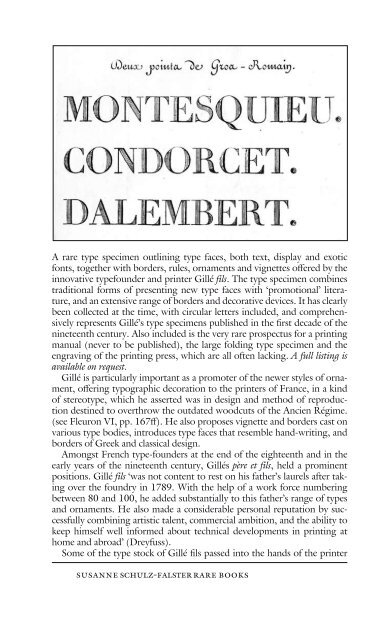Hebrew Printing in Sabbioneta 1 AFFO, Ireneo - Schulz-Falster Rare ...
Hebrew Printing in Sabbioneta 1 AFFO, Ireneo - Schulz-Falster Rare ...
Hebrew Printing in Sabbioneta 1 AFFO, Ireneo - Schulz-Falster Rare ...
You also want an ePaper? Increase the reach of your titles
YUMPU automatically turns print PDFs into web optimized ePapers that Google loves.
A rare type specimen outl<strong>in</strong><strong>in</strong>g type faces, both text, display and exotic<br />
fonts, together with borders, rules, ornaments and vignettes oVered by the<br />
<strong>in</strong>novative typefounder and pr<strong>in</strong>ter Gillé fils. The type specimen comb<strong>in</strong>es<br />
traditional forms of present<strong>in</strong>g new type faces with ‘promotional’ literature,<br />
and an extensive range of borders and decorative devices. It has clearly<br />
been collected at the time, with circular letters <strong>in</strong>cluded, and comprehensively<br />
represents Gillé’s type specimens published <strong>in</strong> the Wrst decade of the<br />
n<strong>in</strong>eteenth century. Also <strong>in</strong>cluded is the very rare prospectus for a pr<strong>in</strong>t<strong>in</strong>g<br />
manual (never to be published), the large fold<strong>in</strong>g type specimen and the<br />
engrav<strong>in</strong>g of the pr<strong>in</strong>t<strong>in</strong>g press, which are all often lack<strong>in</strong>g. A full list<strong>in</strong>g is<br />
available on request.<br />
Gillé is particularly important as a promoter of the newer styles of ornament,<br />
oVer<strong>in</strong>g typographic decoration to the pr<strong>in</strong>ters of France, <strong>in</strong> a k<strong>in</strong>d<br />
of stereotype, which he asserted was <strong>in</strong> design and method of reproduction<br />
dest<strong>in</strong>ed to overthrow the outdated woodcuts of the Ancien Régime.<br />
(see Fleuron VI, pp. 167V). He also proposes vignette and borders cast on<br />
various type bodies, <strong>in</strong>troduces type faces that resemble hand-writ<strong>in</strong>g, and<br />
borders of Greek and classical design.<br />
Amongst French type-founders at the end of the eighteenth and <strong>in</strong> the<br />
early years of the n<strong>in</strong>eteenth century, Gillés père et fils, held a prom<strong>in</strong>ent<br />
positions. Gillé fils ‘was not content to rest on his father’s laurels after tak<strong>in</strong>g<br />
over the foundry <strong>in</strong> 1789. With the help of a work force number<strong>in</strong>g<br />
between 80 and 100, he added substantially to this father’s range of types<br />
and ornaments. He also made a considerable personal reputation by successfully<br />
comb<strong>in</strong><strong>in</strong>g artistic talent, commercial ambition, and the ability to<br />
keep himself well <strong>in</strong>formed about technical developments <strong>in</strong> pr<strong>in</strong>t<strong>in</strong>g at<br />
home and abroad’ (Dreyfuss).<br />
Some of the type stock of Gillé Wls passed <strong>in</strong>to the hands of the pr<strong>in</strong>ter<br />
susanne schulz-falster rare books
















